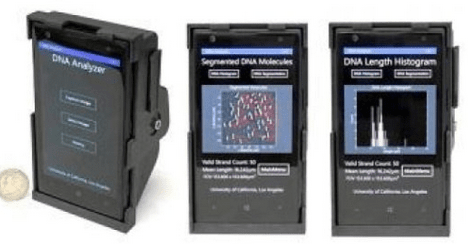Optical Attachment That Turns Smartphone Into DNA-Scanning Microscope
Smartphone usage has increased tremendously across the globe. The device can even be turned into a high-resolution microscope for studying the basic building blocks of living organisms-cells. But now, the optical attachment developed by the researchers from the University of California, Los Angeles (UCLA) can transform any smartphone into a fluorescent microscope that can scan DNA molecules having width of about two nanometers when stretched. This revolutionary device when attached to the smartphone has the potential of imaging and scanning an individual DNA molecule that is 50,000 times thinner when compared to a human hair. The tool is intended to be used for diagnosing various types of cancers and nervous system disorders, such as Alzheimer's. Plus, this less expensive gadget can find drug resistance in infectious diseases.

The compact attachment is built by using an external lens, thin-film interference filter, miniature dovetail stage mount for making fine alignments, and a laser diode. These components are assembled in a small, 3D-printed case. According to Aydogan Ozcan, HHMI Chancellor Professor, UCLA, it is essential to first separate and label the desired DNA with fluorescent tags before using the camera for imaging. In order to scan the DNA molecule, the team developed a computational interface and Windows smart application that runs on the same smartphone. After scanning, the length of the DNA can be measured in less than 10 seconds by using the scanned information that is sent to the laboratory’s remote server. While performing the research, there was a significant drop in the accuracy of the device owing to the reduced detection signal-to-noise ratio. This issue was then resolved by using lens with a higher numerical aperture.
The gel electrophoresis, a conventional method used in biochemistry and molecular biology, is employed for sizing DNA and RNA fragments. However, the disadvantage of this technique is that it cannot differentiate high molecular weight DNA fragments easily. Ozcan proposes that the team’s latest platform could solve this problem. The team further plans to detect the presence of malaria-related drug resistance via its optical attachment.
Source: #-Link-Snipped-#
The compact attachment is built by using an external lens, thin-film interference filter, miniature dovetail stage mount for making fine alignments, and a laser diode. These components are assembled in a small, 3D-printed case. According to Aydogan Ozcan, HHMI Chancellor Professor, UCLA, it is essential to first separate and label the desired DNA with fluorescent tags before using the camera for imaging. In order to scan the DNA molecule, the team developed a computational interface and Windows smart application that runs on the same smartphone. After scanning, the length of the DNA can be measured in less than 10 seconds by using the scanned information that is sent to the laboratory’s remote server. While performing the research, there was a significant drop in the accuracy of the device owing to the reduced detection signal-to-noise ratio. This issue was then resolved by using lens with a higher numerical aperture.
The gel electrophoresis, a conventional method used in biochemistry and molecular biology, is employed for sizing DNA and RNA fragments. However, the disadvantage of this technique is that it cannot differentiate high molecular weight DNA fragments easily. Ozcan proposes that the team’s latest platform could solve this problem. The team further plans to detect the presence of malaria-related drug resistance via its optical attachment.
Source: #-Link-Snipped-#
0
